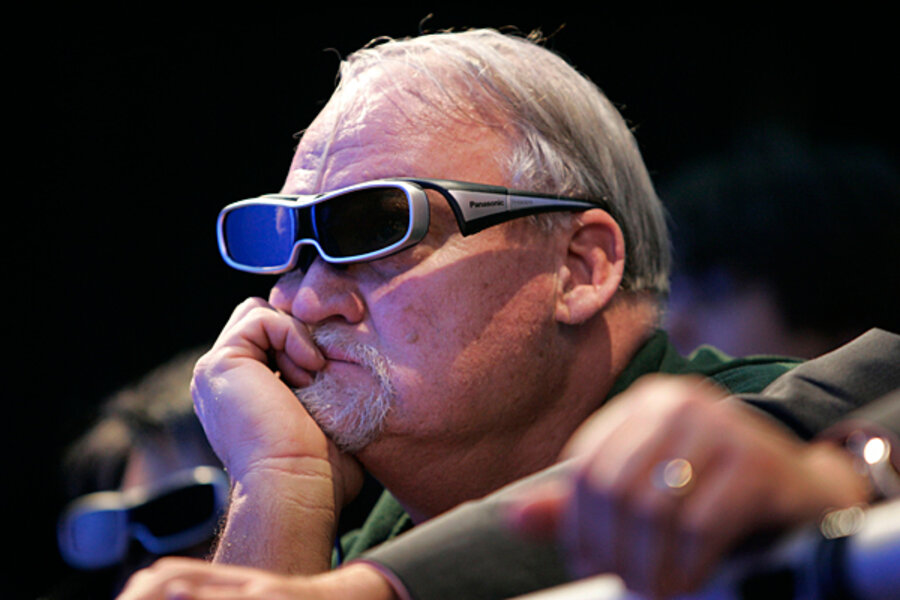Why 3D movies are falling flat this summer
Loading...
| Los Angeles
The 3D backlash has begun.
Everyone from panels of top filmmakers at Comic-Con to the young moviegoers Hollywood most desires is giving the technology the thumbs-down.
The summer’s top live-action hit, “Inception,” is the work of a filmmaker who politely, but firmly, declines to shoot in 3D. So, say box office analysts, marketing pros, technology insiders and a range of moviegoers, for the moment at least, the bloom is off the 3D rose.
“It’s becoming downright cool not to like 3D,” says hollywood.com box office analyst Paul Dergarabedian. “We all knew this was coming because with all that hype, if something seems to be too good to be true, it usually is.” The pullback is evident on both the creative and the moviegoing front, he adds. “ I saw the Jon Favreau clip all over the Internet,” he says referring to the director’s comment that fans should go see his film, “Cowboys & Aliens” twice in regular 2D. “There are a number of big filmmakers who just don’t want to use it,” he points out, adding that moviegoers are watching their bottom line.
“Now that the ticket prices have broken $20, a lot of moviegoers just don’t see the value of paying that much.”
The antipathy goes beyond mere money for some. Duke University junior Zach Davis says he's "very anti-3D.” The son of an actor and a casting agent, he says 3D “distracts from the narrative and makes it hard to follow the story." Most of his friends feel the same way, he says, noting that the clumsy glasses interfere with the social side of moviegoing. “The goggles cut off your peripheral vision and you can’t bond with anyone you’ve come to the theater with.”
Avid videogamer Jeff Torres, arguably as comfortable with cutting-edge gear as any audience member, he says he's "not a big fan of 3D” films. The 25-year-old- actor calls it a “marketing gimmick to get people to pay more for a movie.”
He says he went to “Avatar,” the James Cameron blockbuster which for many, ushered in the current enthusiasm for the technology. “I got tired of wearing the glasses for more than two hours and I didn’t really think it added that much to the story.” Mr. Torres says he would have preferred the “Avatar” adventure as a videogame because then he would have been in control of exploring the environment, rather than being forced to wear the glasses in a passive mode for the length of the film. “I really hope that more filmmakers don’t start using 3D,” he adds.
This level of disenchantment with a prominent technology suggests a problem, says marketing specialist Adam Hanft. “We are in a period of technology adoption where people are accustomed to learning about something new,” he says. The discontent over so much of the 3D landscape arises from a cognitive dissonance between the cultural expectation of progressive technology and the experience many are having in the theater.
“The 3D gear doesn’t seem to be materially advancing while so much of the rest of the consumer technology we experience is evolving rapidly. There’s a new iPhone every few months, it seems like," he says. There is a level of dissatisfaction with the gear that isn’t offset by a significant value added to the moviegoing experience, he adds. Every new, transformative technology in recent history has had an accompanying marketing push to support the technology itself, something 3D lacks. Technicolor, for instance, he says, was sold to audiences as a value in and of itself, and contributed to its acceptance. “3D needs a trade group to sell it,” he says with a laugh.
The dip in enthusiasm for 3D is to be expected, says David Wertheimer, executive director of the Entertainment Technology Center at The University of Southern California. The timeline for the meaningful integration of such a relatively new tool is much longer than most moviegoers' attention spans, he points out.
“Avatar produced a big rush of attention and everyone expected 3D to be the next big thing for all time,” says Mr. Wetheimer, but most of this summer’s slate of films were in production long before the James Cameron blockbuster arrived in theaters. He says the technology, which is transforming everything from sports events to rock concerts, videogames, laptops, and mobile phones, is here to stay. “It’s just going to take a little longer than some people might like to perfect it as a tool.”
Related:





